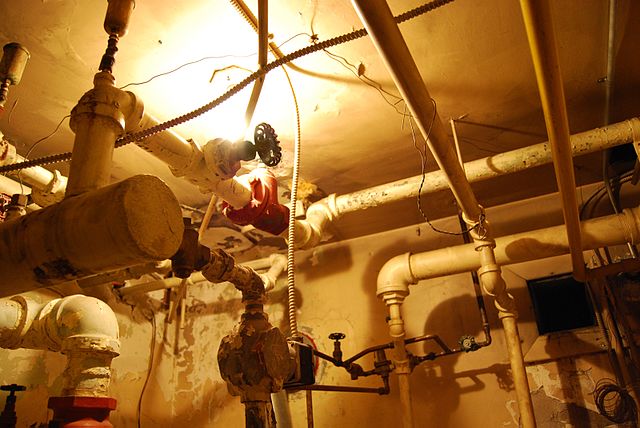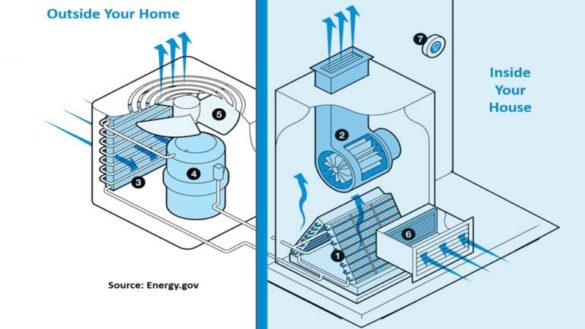Breaking Down The Layout of Your Property's Plumbing System
Breaking Down The Layout of Your Property's Plumbing System
Blog Article
We've noticed this article relating to The Inner Workings of Your Home's Plumbing directly below on the net and think it made perfect sense to share it with you on my blog.

Comprehending how your home's plumbing system works is vital for every homeowner. From delivering clean water for alcohol consumption, food preparation, and bathing to safely removing wastewater, a well-maintained pipes system is critical for your family members's wellness and convenience. In this detailed guide, we'll check out the elaborate network that makes up your home's pipes and deal ideas on upkeep, upgrades, and dealing with typical problems.
Introduction
Your home's pipes system is greater than just a network of pipes; it's a complex system that guarantees you have accessibility to clean water and efficient wastewater removal. Recognizing its parts and exactly how they collaborate can help you protect against pricey repair services and ensure every little thing runs smoothly.
Basic Elements of a Pipes System
Pipes and Tubes
At the heart of your pipes system are the pipes and tubes that lug water throughout your home. These can be made from various products such as copper, PVC, or PEX, each with its advantages in regards to longevity and cost-effectiveness.
Fixtures: Sinks, Toilets, Showers, etc.
Components like sinks, bathrooms, showers, and bathtubs are where water is made use of in your home. Understanding exactly how these fixtures attach to the pipes system helps in identifying troubles and preparing upgrades.
Valves and Shut-off Factors
Valves regulate the circulation of water in your plumbing system. Shut-off shutoffs are essential throughout emergency situations or when you need to make fixings, enabling you to separate parts of the system without interrupting water circulation to the entire residence.
Supply Of Water System
Key Water Line
The primary water line connects your home to the local water supply or an exclusive well. It's where water enters your home and is distributed to numerous fixtures.
Water Meter and Stress Regulator
The water meter procedures your water usage, while a stress regulator makes sure that water flows at a risk-free pressure throughout your home's plumbing system, preventing damage to pipelines and fixtures.
Cold Water vs. Warm water Lines
Understanding the distinction in between cold water lines, which supply water directly from the primary, and warm water lines, which carry warmed water from the hot water heater, assists in repairing and planning for upgrades.
Water drainage System
Drain Pipeline and Traps
Drain pipelines carry wastewater far from sinks, showers, and bathrooms to the sewage system or septic tank. Traps prevent sewage system gases from entering your home and likewise catch debris that might create clogs.
Ventilation Pipelines
Ventilation pipes enable air right into the drainage system, stopping suction that can slow drainage and trigger traps to vacant. Correct air flow is essential for preserving the stability of your pipes system.
Importance of Correct Water Drainage
Guaranteeing appropriate water drainage protects against backups and water damage. On a regular basis cleansing drains and maintaining traps can stop pricey fixings and extend the life of your plumbing system.
Water Heating Unit
Kinds Of Hot Water Heater
Hot water heater can be tankless or traditional tank-style. Tankless heaters heat water on demand, while storage tanks save heated water for immediate use.
Exactly How Water Heaters Link to the Pipes System
Comprehending just how hot water heater attach to both the cold water supply and warm water circulation lines aids in detecting concerns like not enough warm water or leakages.
Upkeep Tips for Water Heaters
Consistently purging your hot water heater to get rid of sediment, examining the temperature level setups, and inspecting for leakages can expand its lifespan and improve power performance.
Usual Pipes Concerns
Leakages and Their Causes
Leaks can occur due to aging pipes, loosened installations, or high water stress. Attending to leakages without delay stops water damages and mold growth.
Blockages and Blockages
Clogs in drains and bathrooms are typically triggered by flushing non-flushable items or a build-up of oil and hair. Utilizing drain screens and being mindful of what goes down your drains can protect against obstructions.
Indications of Pipes Troubles to Expect
Low tide pressure, slow-moving drains pipes, foul odors, or uncommonly high water bills are indicators of possible plumbing problems that should be resolved without delay.
Plumbing Maintenance Tips
Normal Assessments and Checks
Arrange annual pipes evaluations to catch concerns early. Search for signs of leakages, rust, or mineral buildup in taps and showerheads.
DIY Upkeep Tasks
Simple jobs like cleaning faucet aerators, checking for toilet leakages using color tablets, or insulating subjected pipes in cool climates can protect against significant plumbing issues.
When to Call a Specialist Plumbing
Know when a plumbing problem requires expert competence. Attempting intricate repair work without correct knowledge can cause even more damage and higher fixing expenses.
Updating Your Pipes System
Reasons for Updating
Updating to water-efficient fixtures or changing old pipelines can enhance water top quality, decrease water costs, and boost the value of your home.
Modern Plumbing Technologies and Their Advantages
Explore innovations like clever leak detectors, water-saving toilets, and energy-efficient hot water heater that can save cash and decrease ecological impact.
Expense Factors To Consider and ROI
Determine the ahead of time costs versus long-lasting financial savings when thinking about pipes upgrades. Many upgrades spend for themselves with lowered utility bills and less fixings.
Environmental Effect and Preservation
Water-Saving Fixtures and Home Appliances
Setting up low-flow taps, showerheads, and toilets can dramatically lower water usage without sacrificing efficiency.
Tips for Minimizing Water Use
Basic routines like dealing with leaks quickly, taking shorter showers, and running complete tons of washing and recipes can preserve water and reduced your energy bills.
Eco-Friendly Pipes Options
Think about sustainable pipes materials like bamboo for flooring, which is durable and eco-friendly, or recycled glass for kitchen counters.
Emergency Readiness
Actions to Take During a Plumbing Emergency situation
Know where your shut-off shutoffs are located and exactly how to switch off the water supply in case of a ruptured pipe or significant leak.
Value of Having Emergency Get In Touches With Helpful
Keep get in touch with details for regional plumbers or emergency solutions conveniently available for fast response during a pipes crisis.
DIY Emergency Fixes (When Suitable).
Short-term solutions like utilizing air duct tape to patch a dripping pipe or placing a pail under a leaking faucet can decrease damages up until a professional plumber gets here.
Final thought.
Understanding the makeup of your home's pipes system empowers you to keep it successfully, conserving money and time on repair services. By complying with routine maintenance routines and staying educated regarding modern-day pipes innovations, you can ensure your pipes system runs effectively for many years to come.
Understanding Your Home Plumbing System: A Comprehensive Guide
Plumbing System: The Lifeline of Your Home
At its core, the plumbing system is designed to perform two primary functions: bring fresh water into your home and remove wastewater. The system is a network of pipes, fixtures, and other components that transport water and sewage. Residential plumbing systems include potable water supply lines, drain-waste-vent (DWV) systems, and various plumbing fixtures that make water use in daily tasks possible.
Key Components:
Water Supply: This part of your plumbing system brings municipal water into your home, passing through the main water supply line. It s responsible for supplying all water needs, from drinking to bathing.
Drainage System: It carries waste and water away from your home to the sewer or septic system. This system includes all the piping within your home that leads to external sewage or septic systems.
Vent System: An essential yet often overlooked component, the vent system allows sewer gases to escape and lets air into the drainpipes, ensuring water and waste move correctly through the system.
Fixture: More Than Just Taps and Toilets
Plumbing fixtures are the most interactive parts of the plumbing system, including faucets, showers, toilets, and sinks. Each fixture is connected to the plumbing system and plays a role in either the delivery of freshwater or the disposal of waste and wastewater.
Types of Fixtures:
Faucets and Sinks: Used for washing hands, dishes, and other daily water needs.
Toilets: Dispose of human waste through the sewage system.
Bathtubs and Showers: Provide bathing facilities, requiring both hot and cold water supply.
Water Supply: The Source of Life
The water supply system is a critical component, ensuring that potable water is available throughout your home for various uses, including drinking, cooking, and cleaning. This system consists of pipes that distribute water to different parts of the house, controlled by valves to regulate the water flow.
Types of Plumbing: Materials and Methods
Various types of plumbing systems and materials are used in residential settings, each with its advantages and applications. From copper and PVC pipes for water supply to cast iron and ABS for drainage, the choice of materials can impact the longevity and efficiency of your plumbing system.
https://intownplumbingtx.com/articles/home-plumbing-system-guide/

Understanding Your Home Plumbing System: A Comprehensive Guide
Plumbing System: The Lifeline of Your Home
At its core, the plumbing system is designed to perform two primary functions: bring fresh water into your home and remove wastewater. The system is a network of pipes, fixtures, and other components that transport water and sewage. Residential plumbing systems include potable water supply lines, drain-waste-vent (DWV) systems, and various plumbing fixtures that make water use in daily tasks possible.
Key Components:
Water Supply: This part of your plumbing system brings municipal water into your home, passing through the main water supply line. It s responsible for supplying all water needs, from drinking to bathing.
Drainage System: It carries waste and water away from your home to the sewer or septic system. This system includes all the piping within your home that leads to external sewage or septic systems.
Vent System: An essential yet often overlooked component, the vent system allows sewer gases to escape and lets air into the drainpipes, ensuring water and waste move correctly through the system.
Fixture: More Than Just Taps and Toilets
Plumbing fixtures are the most interactive parts of the plumbing system, including faucets, showers, toilets, and sinks. Each fixture is connected to the plumbing system and plays a role in either the delivery of freshwater or the disposal of waste and wastewater.
Types of Fixtures:
Water Supply: The Source of Life
The water supply system is a critical component, ensuring that potable water is available throughout your home for various uses, including drinking, cooking, and cleaning. This system consists of pipes that distribute water to different parts of the house, controlled by valves to regulate the water flow.
Types of Plumbing: Materials and Methods
Various types of plumbing systems and materials are used in residential settings, each with its advantages and applications. From copper and PVC pipes for water supply to cast iron and ABS for drainage, the choice of materials can impact the longevity and efficiency of your plumbing system.
https://intownplumbingtx.com/articles/home-plumbing-system-guide/
We hope you enjoyed reading our post about . Thanks a ton for taking a few minutes to read our piece of content. If you please take the opportunity to distribute this article if you liked it. I take joy in reading our article about .
Call Today Report this page